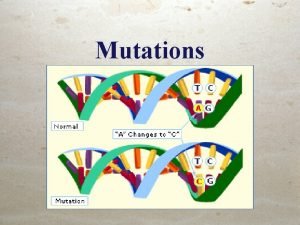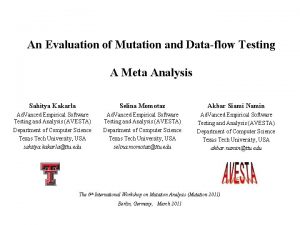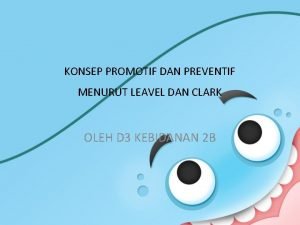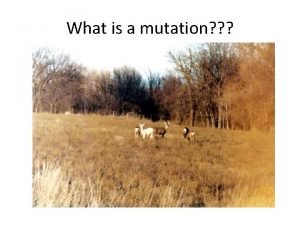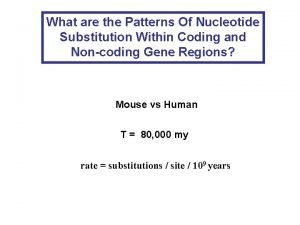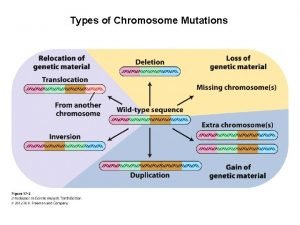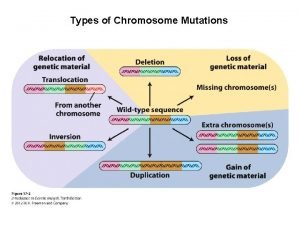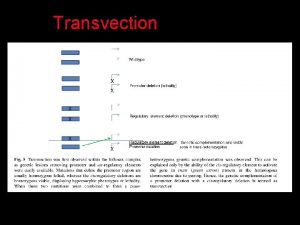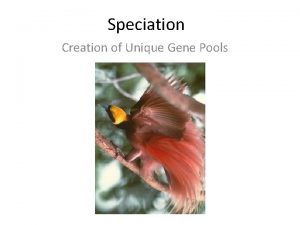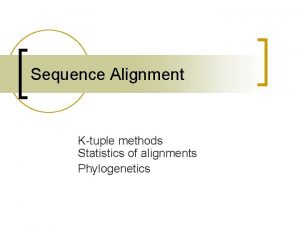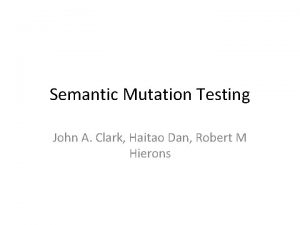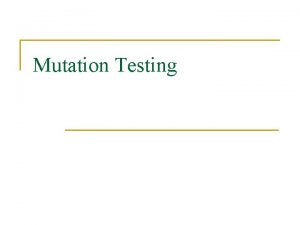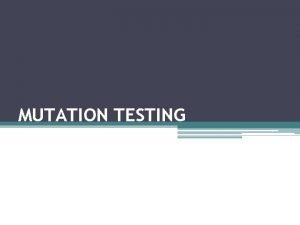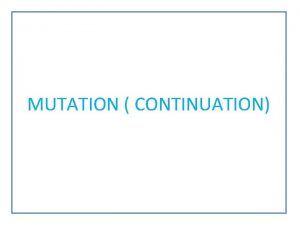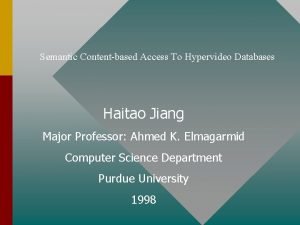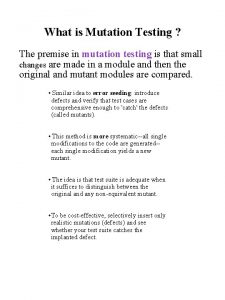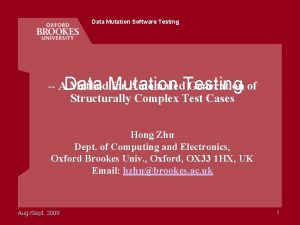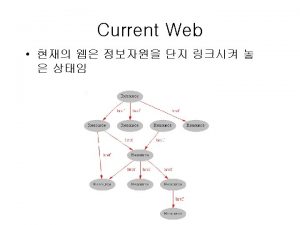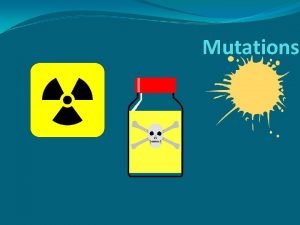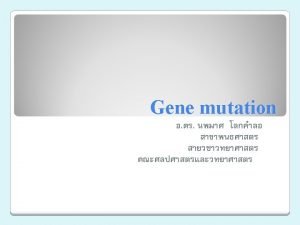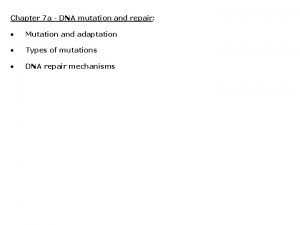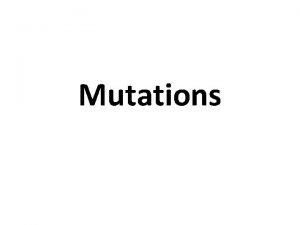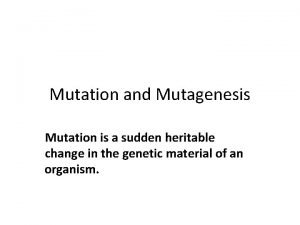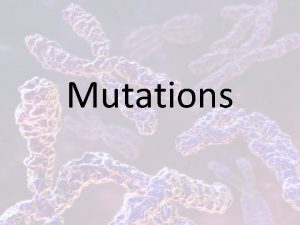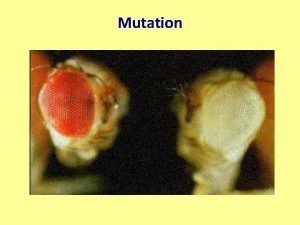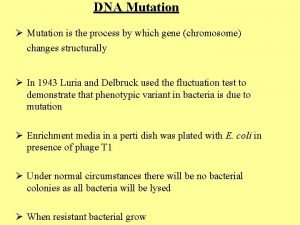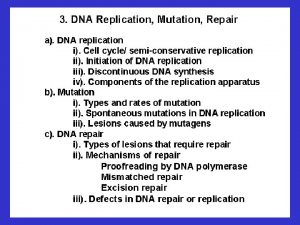Semantic Mutation Testing John A Clark Haitao Dan




























- Slides: 28

Semantic Mutation Testing John A. Clark, Haitao Dan, and Robert M. Hierons Andreas Voraberger 13. 01. 2014 Andreas Voraberger AK Softwaretechnologie 1 WS 2013/14 1

Content • Introduction • Traditional Mutation Testing • • The idea Mutation count Possibilities Advantages / Disadvantages • Semantic Mutation Testing • • • The idea Implementing semantic mutation Advantages Semantic Error Model Common misunderstandings Refinement Translation Example (Cruise-control system) Conclusion Andreas Voraberger AK Softwaretechnologie 1 WS 2013/14 2

Introduction • Testing is important but expensive • 50% of development budget • Test automation • More efficient/effective • Mutation Testing • Distinguishing between descriptions (N) • Semantic Mutation Testing • Distinguishing between semantics (L) Andreas Voraberger AK Softwaretechnologie 1 WS 2013/14 3

Introduction • Code defined by the pair: (N, L) • N: the description (source code) • L: the semantics of the language Andreas Voraberger AK Softwaretechnologie 1 WS 2013/14 4

Traditional Mutation Testing Andreas Voraberger AK Softwaretechnologie 1 WS 2013/14 5

The idea • Mutants are classes of faults • Produce mutants (N’) • Making changes to the program • Apply mutation operators • {+, -} • {<=, <} • {delete parts} • (N, L) (N‘, L) • Test Cases should distinguish N/N‘ (mutant killed) Andreas Voraberger AK Softwaretechnologie 1 WS 2013/14 6

Mutation count • Single mutation operator creates large number of mutations • Even in small programs • Only use “first-order mutants“ • Produced by application of one operator • Hypothesis: all “first-order mutants“ kill most “higher-order mutants“ • Equivalent mutant: not kill able Andreas Voraberger AK Softwaretechnologie 1 WS 2013/14 7

Possibilities 1. Judge test data against the mutants created 2. Produce test data to kill all mutants • A test set that is good in distinguishing N from N’ is good at finding faults Andreas Voraberger AK Softwaretechnologie 1 WS 2013/14 8

Advantages • Target particular classes of faults • Optimal for small slips or typos • Simulate other test criteria • Mutants lead to errors provide coverage Andreas Voraberger AK Softwaretechnologie 1 WS 2013/14 9

Disadvantages • High number of mutants, even with • Only “first-order mutants“ • Small programs • Solution: “selective mutation“ • Equivalent mutants • Leads to manual effort • Increases costs • Doesn’t aim on semantic mistakes Andreas Voraberger AK Softwaretechnologie 1 WS 2013/14 10

Semantic Mutation Testing (SMT) Overview Andreas Voraberger AK Softwaretechnologie 1 WS 2013/14 11

The idea • Produce mutants (L’) • (N, L) (N, L‘) • Discover misunderstandings related to semantic mistakes • Requires description language with a semantics that allows manipulation Andreas Voraberger AK Softwaretechnologie 1 WS 2013/14 12

Implementing semantic mutation • Parameterisable system • Mutate through changing the parameters • Express semantics that can be manipulated • A set of rewrite rules • Simulate a mutation of the semantics • Changes to the syntax throughout the description Andreas Voraberger AK Softwaretechnologie 1 WS 2013/14 13

Advantages • Lead to far fewer mutants • Fewer equivalent mutants • Tests translation, refinement, migration, porting code • Eliminates misunderstandings Andreas Voraberger AK Softwaretechnologie 1 WS 2013/14 14

Semantic Mutation Testing (SMT) Scenarios Andreas Voraberger AK Softwaretechnologie 1 WS 2013/14 15

Semantic Error Model • Change of description in development process • Abstract Concrete 1. 2. 3. 4. 5. Requirements Specification Design Code Machine code • Misunderstandings in every transformation Andreas Voraberger AK Softwaretechnologie 1 WS 2013/14 16

Semantic Error Model Andreas Voraberger AK Softwaretechnologie 1 WS 2013/14 17

Semantic Error Model • Refinement • Transformation to different abstraction level • Translation • Transformation on the same abstraction level Basis for misunderstandings Solution: SMT Andreas Voraberger AK Softwaretechnologie 1 WS 2013/14 18

Common misunderstandings • Find set of semantic misunderstandings • For different languages • Based on studies or experience • Implement tests, finding them • Set of operators should reflect the environment • Different mistakes depending on programmer skills Andreas Voraberger AK Softwaretechnologie 1 WS 2013/14 19

Refinement • Semantic mistakes between abstraction levels • Problems on copying syntax • Maybe different semantics • Examples • • • Truncation rules Precedence rules Datatypes Floating point precision Binary representation Andreas Voraberger AK Softwaretechnologie 1 WS 2013/14 20

Migration / Porting (Translation) • Migration / Porting to a different language • Maybe different semantics • Use a semantic test case generation tool • Suits of semantic mutation operators for common combinations • Point to common failures • Example: C to Z • Division of negative numbers • Branching structures • floating-point comparison Andreas Voraberger AK Softwaretechnologie 1 WS 2013/14 21

Semantic Mutation Testing (SMT) Example Andreas Voraberger AK Softwaretechnologie 1 WS 2013/14 22

Example • Shows • cruise-control system • Not only slips have to be tested • Developers can make semantic mistakes Andreas Voraberger AK Softwaretechnologie 1 WS 2013/14 23

Statechart for a cruise-control system Andreas Voraberger AK Softwaretechnologie 1 WS 2013/14 24

Cruise-control system (Case 1) • State: no_vehicle_in_front • Events: • brake • level=increase • What happens? Andreas Voraberger AK Softwaretechnologie 1 WS 2013/14 25

Cruise-control system (Case 2) • State: no_vehicle_in_front • Events: • Vehicle detected • level=increase • What happens? Andreas Voraberger AK Softwaretechnologie 1 WS 2013/14 26

Conclusion • Semantic Testing is necessary • SMT is a working practice • Captures a different failure type than MT • Focuses on misunderstandings • Normal MT still necessary Andreas Voraberger AK Softwaretechnologie 1 WS 2013/14 27

Quelle • John A. Clark, Haitao Dan, and Robert M. Hierons. Semantic mutation testing. In Third International Conference on Software Testing, Verification, and Validation Workshops, pages 100 -109. IEEE, 2010 Andreas Voraberger AK Softwaretechnologie 1 WS 2013/14 28
 Mutations are any mistake or change in the...
Mutations are any mistake or change in the... Functions of marketing by clark and clark
Functions of marketing by clark and clark Data flow and mutation testing
Data flow and mutation testing Five level prevention menurut leavel and clark
Five level prevention menurut leavel and clark What is domain testing
What is domain testing Logic based testing in software testing
Logic based testing in software testing Du path testing
Du path testing Positive negative testing
Positive negative testing Static testing and dynamic testing
Static testing and dynamic testing Globalization testing in software testing
Globalization testing in software testing Functional testing vs unit testing
Functional testing vs unit testing Language testing
Language testing Control structure testing in software testing
Control structure testing in software testing Decision table testing in software testing
Decision table testing in software testing What is decision table testing
What is decision table testing Apa itu blackbox testing
Apa itu blackbox testing Behavior testing adalah
Behavior testing adalah Limited entry decision table
Limited entry decision table Rigorous testing in software testing
Rigorous testing in software testing Testing blindness in software testing
Testing blindness in software testing Component testing is a black box testing
Component testing is a black box testing Domain example
Domain example Glu to val mutation
Glu to val mutation Synonymous vs nonsynonymous mutation
Synonymous vs nonsynonymous mutation Chromosomal mutation deletion
Chromosomal mutation deletion Deletion chromosomal mutation
Deletion chromosomal mutation Hox gene mutation in drosophila
Hox gene mutation in drosophila Hox gene mutation in drosophila
Hox gene mutation in drosophila Nonsynonymous mutation vs synonymous
Nonsynonymous mutation vs synonymous
